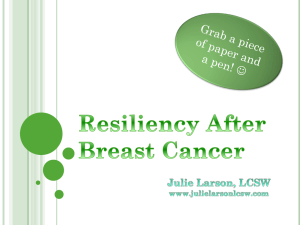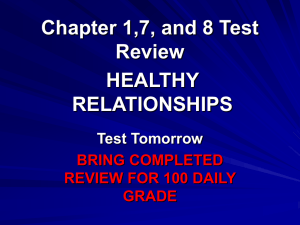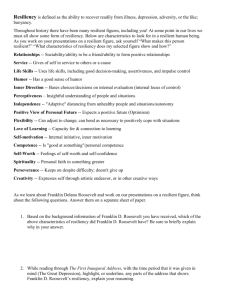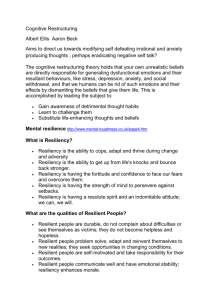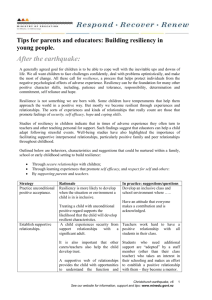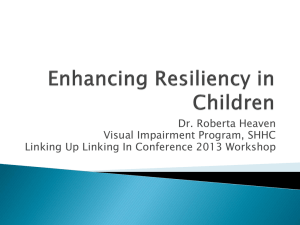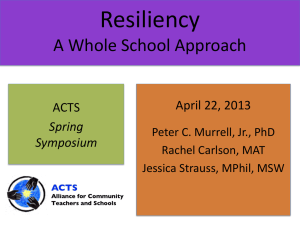Schoolwide Methods for Fostering Resiliency Student Services B
advertisement
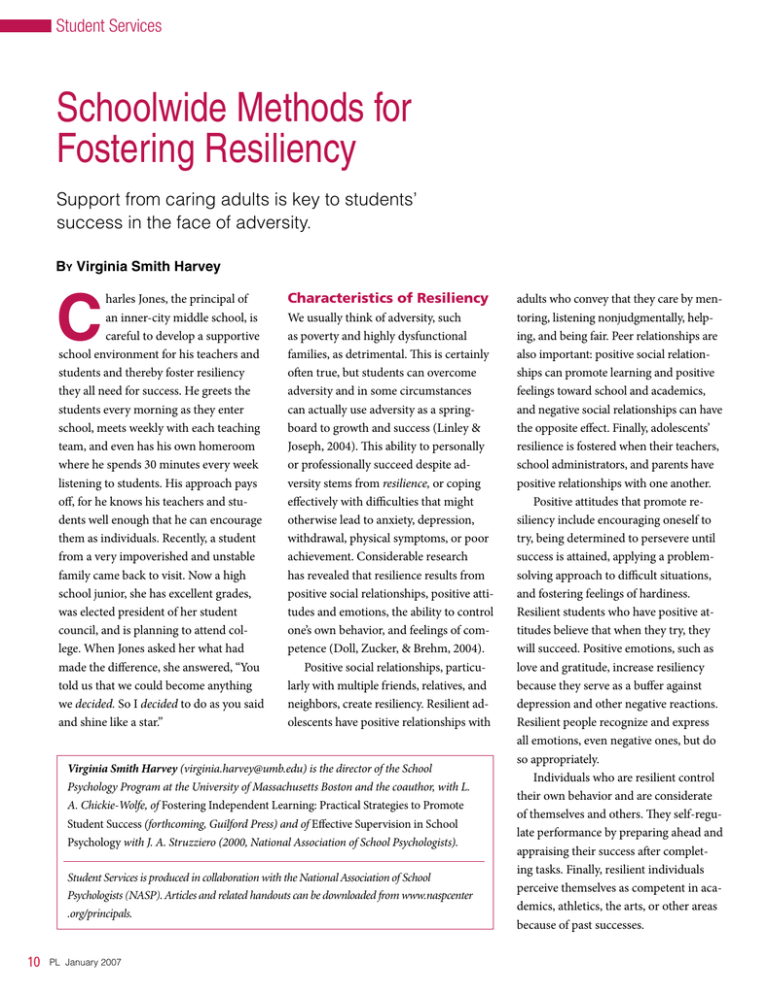
Student Services Schoolwide Methods for Fostering Resiliency Support from caring adults is key to students’ success in the face of adversity. By Virginia Smith Harvey C harles Jones, the principal of an inner-city middle school, is careful to develop a supportive school environment for his teachers and students and thereby foster resiliency they all need for success. He greets the students every morning as they enter school, meets weekly with each teaching team, and even has his own homeroom where he spends 30 minutes every week listening to students. His approach pays off, for he knows his teachers and students well enough that he can encourage them as individuals. Recently, a student from a very impoverished and unstable family came back to visit. Now a high school junior, she has excellent grades, was elected president of her student council, and is planning to attend college. When Jones asked her what had made the difference, she answered, “You told us that we could become anything we decided. So I decided to do as you said and shine like a star.” Characteristics of Resiliency We usually think of adversity, such as poverty and highly dysfunctional families, as detrimental. This is certainly often true, but students can overcome adversity and in some circumstances can actually use adversity as a springboard to growth and success (Linley & Joseph, 2004). This ability to personally or professionally succeed despite adversity stems from resilience, or coping effectively with difficulties that might otherwise lead to anxiety, depression, withdrawal, physical symptoms, or poor achievement. Considerable research has revealed that resilience results from positive social relationships, positive attitudes and emotions, the ability to control one’s own behavior, and feelings of competence (Doll, Zucker, & Brehm, 2004). Positive social relationships, particularly with multiple friends, relatives, and neighbors, create resiliency. Resilient adolescents have positive relationships with Virginia Smith Harvey (virginia.harvey@umb.edu) is the director of the School Psychology Program at the University of Massachusetts Boston and the coauthor, with L. A. Chickie-Wolfe, of Fostering Independent Learning: Practical Strategies to Promote Student Success (forthcoming, Guilford Press) and of Effective Supervision in School Psychology with J. A. Struzziero (2000, National Association of School Psychologists). Student Services is produced in collaboration with the National Association of School Psychologists (NASP). Articles and related handouts can be downloaded from www.naspcenter .org/principals. 10 PL January 2007 adults who convey that they care by mentoring, listening nonjudgmentally, helping, and being fair. Peer relationships are also important: positive social relationships can promote learning and positive feelings toward school and academics, and negative social relationships can have the opposite effect. Finally, adolescents’ resilience is fostered when their teachers, school administrators, and parents have positive relationships with one another. Positive attitudes that promote resiliency include encouraging oneself to try, being determined to persevere until success is attained, applying a problemsolving approach to difficult situations, and fostering feelings of hardiness. Resilient students who have positive attitudes believe that when they try, they will succeed. Positive emotions, such as love and gratitude, increase resiliency because they serve as a buffer against depression and other negative reactions. Resilient people recognize and express all emotions, even negative ones, but do so appropriately. Individuals who are resilient control their own behavior and are considerate of themselves and others. They self-regulate performance by preparing ahead and appraising their success after completing tasks. Finally, resilient individuals perceive themselves as competent in academics, athletics, the arts, or other areas because of past successes. Fostering Resiliency Supporting positive relationships among students and adults. To develop resilience, adolescents need to be cared for and supported by adults in school, at home, and in the community. Teacherstudent relationships often reflect administrator-teacher relationships: to provide the support and encouragement that adolescents require, teachers and staff members must feel supported and encouraged by their school administrators. Administrators therefore need to take care that they foster the same respectful and positive relationships with teachers and staff members that they would like teachers and staff members to form with students. In addition, it can be helpful to structure the school setting so every student has adults in whom he or she can trust and confide. For example, Jones assigned every adult in the building, including himself, a homeroom with the same students for multiple years. Many secondary schools schedule regular afterschool sessions by subject area to foster teacher-student communication. Others use student journals or reaction papers for the same purpose. Some schools take steps to reduce the functional ratios of teachers to students (Pianta, 1999). For example, block schedules in which each student has three major classes each semester, rather than six classes all year, increase opportunities for communication and relationship building between teachers and students because each teacher has half as many students per semester. All these approaches give adults opportunities to take an essential step in developing positive relationships: finding something—or several things—to like about each student. Many students from adverse backgrounds have a long history of negative interaction with adults and tend to anticipate that future interaction with adults will be negative. To reverse this pattern, adults must deliberately, repeatedly, and genuinely communicate positive regard. To support positive relationships, it is important that teachers praise more than they criticize. In general, praise for success can be given in public, because praise often increases such positive emotions as pride, but criticism should be given in private because it increases defensiveness and anxiety. Schools that promote resilience also promote positive peer relationships and prosocial behaviors, such as helping, sharing, cooperating, collaborative problem solving, and treating others with respect and courtesy. Positive peer relationships are fostered through an emphasis on learning rather than competition. This emphasis can be supported by well-designed and interesting cooperative learning projects in which all students must contribute to the final learning product. When students help others, they develop resiliency. Violence prevention, antibullying, peer mediation programs, and initiatives that encourage students to accept and sponsor less popular students all foster resiliency (Doll, Zucker, & Brehm, 2004). Further, schools that foster resiliency also promote positive relationships between home and school. Such relationships do not require Factors That Contribute to Resiliency Attitudes and Emotions l Positive attitudes (optimism, determination, problem solving) l Positive emotions (love, gratitude, forgiveness) l Appropriate expression of emotions Competence l Academic success l Regular school attendance and homework completion l Developing talents (outside academic achievement) Social Competence l Connectedness l Structure and clear expectations l Helping others Physical Health l Medical care l Exercise l Adequate sleep l Positive stress control PL January 2007 11 Student Services How Schools Can Foster Resiliency Resiliency gives students the ability to deal with challenges and adapt to new or difficult circumstances in a positive, productive manner. There are number of ways for schools to foster resilience. FP rovide a caring, supportive learning environment. Feeling cared for and safe builds students’ resiliency. Promote positive social connections between staff members and students, students and their peers, and home and school. FF oster positive attitudes. Help students believe that they can succeed if they try. Provide situations in which students are able to succeed. Frame failure as a learning opportunity. Teach them to reevaluate and adjust strategies that may not be working. FN urture positive emotions. Demonstrate and give students the chance to practice positive emotions, such as optimism, respect, forgiveness, and empathy. Train staff members to reinforce emotional intelligence, praise students for successes, and avoid judgmental or harsh criticism for failure. FF oster academic self-determination and feelings of competence. Provide consistent clear expectations. Help students develop a menu of homework and study strategies. Encourage students to regularly attend school and complete homework as well as to develop talents in activities they enjoy. Teach them to set realistic goals and obtain necessary resources. FE ncourage volunteerism. Social competence and resilience are fostered by helping others at home, in school, and in the community. Create and promote a variety of opportunities for students to contribute to the well-being of others both on and off campus. FT each peace-building skills. Learning how to be appropriately assertive without being aggressive fosters resilience. Teach conflictresolution and peer-mediation skills, strategies for standing up to bullies, and violence-prevention strategies. FE nsure healthy habits. Good physical health prepares the body and mind to be more resilient and contributes to school success. Encourage good nutrition through school food offerings, adequate sleep, and exercise through education, and increased opportunities for exercise. Facilitate stress reduction by incorporating positive stress control strategies, such as meditation, controlled breathing, yoga, and exercise into school curricula. Adapted from: “Resiliency: Strategies for Parents and Educators,” Helping Children at Home and School II: Handouts for Families and Educators, NASP, 2004. 12 PL January 2007 parental attendance at school functions, but they do require proactive and regular formal and informal two-way communication between home and school for collaborative priority setting and early interventions so students fully understand that the adults in their lives agree upon the importance of academic success. Encouraging positive attitudes and emotions in students and staff members. For teachers to be able to foster positive attitudes and emotions in students, administrators need to foster the same positive attitudes and emotions in teachers and staff members. It can be particularly helpful for administrators to adopt an approach that stresses a positive outlook. For example, some schools have adopted the Fish! philosophy, which focuses on building relationships, mindfulness, and positive thinking through four principles: Be There, Play, Make Their Day, and Choose Your Attitude (Lundin, 2006; Lundin, Paul, & Christensen, 2000). Adults can help students manage negative emotions by teaching them to name emotions—such as boredom, frustration, anxiety, and anger—and helping them understand that these emotions are normal yet do not preclude appropriate behavior. When administrators and teachers provide “emotion coaching,” they help students become more aware of and able to label emotions, listen empathetically and validate feelings, and derive appropriate ways to solve problems or deal with an upsetting issues (Gottman, Declaire, & Goleman, 1998). Many adverse circumstances, such as abuse and neglect, are caused by other people. In these situations, resiliency is fostered when students learn to forgive others—and themselves—for playing a part in causing adverse circumstances. Forgiving is not the same as forgetting or excusing the harm done. Instead, it is becoming less angry, resentful, fearful, interested in revenge, or remorseful. It is not appropriate for forgiveness to occur while harm is still occurring, but at a later time forgiving increases well-being and fosters empathy. Learning to forgive enables injured people to accept imperfections in all people, including themselves. Individuals who forgive choose to experience, appropriately express, and then let go of negative feelings of anger, guilt, and retaliation. All of these responses increase future resiliency. It is important for administrators to model and encourage such responses. Promoting students’ self-control. For students to develop self-control, adults must first define and foster appropriate behavior and select natural consequences for inappropriate behavior. It is very important that teachers and administrators clearly state their expectations and set clear standards for performance. In secondary schools, administrators and teachers must reach consensus on rules so they are consistent across settings; it can be confusing and disruptive when individual teachers permit behaviors that are against school policy. Reaching such a consensus requires adept administrative skills, because often something that is of vital importance to one person is of little significance to others. Involving students in such collaborative work sessions can also be helpful; students who are involved in setting the rules are more likely to appreciate their importance and more likely to cooperate in and facilitate their implementation. Fostering academic selfdetermination and feelings of competence. Schools that foster resiliency have academic programs with which students can be successful most of the time. Assignments are at an appropriate difficulty level—stimulating, challenging, and manageable. It is best when academic and behavioral directions, expectations, and standards are clear to students; academic work is corrected and returned promptly; students’ effort and accuracy are emphasized; academic success is tied to real-world success; and adults identify such methods to obtain help from others as working with study buddies. Teachers who treat students as individuals and collaborators in the learning process help students become resilient. As often as possible, these teachers encourage students to select learning topics, evaluate their own knowledge, set their own learning goals, and assess their own learning strategies. Administrators and teachers are in an ideal position to help students develop pride in learning by focusing on the improvement of individual skills and using competency-based measures (rather than group norms) as much as possible. Administrators can encourage teachers to link learning about students’ favorite topics with standard academic work; to indulge their natural curiosity regarding a subject about which they are already passionate; and to emphasize assignments that enable students to be active participants, rather than passive learners. Academic success and resiliency are also fostered by the development of good study strategies and self-regulation of academic work. Important study skills include setting goals and tracking academic progress, using good time management strategies, planning and prioritizing activities, using assignment books, breaking large assignments into components, designating a quiet time and place to do homewwwwork for six or more hours per week, and seeking Advertisement PL January 2007 13 help when encountering difficulties. Adults can guide students as they develop these skills and then encourage them to self-regulate their application until they are independently maintained. In addition to academics, every student should develop his or her individual talents to further increase feelings of competence. Which talents—playing a sport, hiking, playing a musical instrument, dancing, drawing, creative writing, bike riding, computer programming— are less important than the feelings of joy and competence that result. Sometimes a talent leads to a career. Most often, it results in an improved ability to deal with stress, becomes a source of friendships, serves as a positive method of self-expression, and is a constructive use of time. Adults play an important role in talent development by providing encouragement, helping adolescents set realistic and manageable goals, problem solving with students, and finding ways to obtain necessary resources. Finally, administrators can foster resiliency by encouraging students to achieve good physical health. They can encourage adolescents to eat well by ensuring, at least in school, that healthy food is readily available and unhealthy food relatively unavailable. By offering intramural sports, aerobics and yoga classes, and other noncompetitive athletics, administrators can promote regular exercise, which not only improves physical health but also decreases the anxiety, anger, and depression that result from adversity. Troubleshooting. At times, administrators will desire a more structured approach to fostering resiliency. In such cases, they can collaborate with teachers and students to assess elements in the school that foster or detract from resiliency and to define and measure missing 14 PL January 2007 elements and the factors contributing to the absence of these elements. To help with such a process, Doll, Zucker, and Brehm (2004) recommend developing “class maps” by surveying students with a questionnaire that taps feelings of academic efficacy, academic selfdetermination, behavior self-control, teacher-student relationships, peer relationships, and home-school relationships. The results are graphed and used to generate whole-class discussions and to develop problem-solving strategies. Similarly, the Classroom Environment Scale (Moos & Trickett, 1987) can be used to assess relationships, personal growth and goal orientation, and system maintenance and change in secondary classrooms. After such an assessment, administrators, teachers, and students can set measurable goals for improvement, collaboratively develop and implement intervention strategies, collect and analyze postintervention data, and modify future procedures accordingly. competence, and fostering the resiliency of teachers and staff members. The more resilient approaches and habits an adolescent develops, the better his or her ability to weather adversities encountered in life. PL References n Doll, B., Zucker, S., & Brehm, K. (2004). Resilient classrooms: Creating healthy environments for learning. New York: Guilford Press. n Gottman, J. M., Declaire, J., & Goleman, D. P. (1998). Raising an emotionally intelligent child. New York: Fireside. n Linley, P. A., & Joseph, S. (2004). Positive change following trauma and adversity: A review. Journal of Traumatic Stress, 17, 11–21. n Lundin, S. C. (2006). Manifesto. Re- trieved May, 7, 2006, from www.charthouse.com n Lundin, S. C., Paul, H., & Christensen, J. (2000). Fish! A remarkable way to boost morale and improve results. New York: Hyperion. Conclusion n Moos, R. H., & Trickett, E. J. (1987). Administrators can foster students’ resiliency by supporting positive relationships, encouraging positive attitudes and emotions, promoting students’ self-control, fostering academic self-determination and feelings of Classroom environment scale (2nd ed.). Palo Alto, CA: Consulting Psychologists Press. n Pianta, R. C. (1999). Enhancing rela- tionships between children and teachers. Washington, DC: American Psychological Association. Resources n Strong Kids (for students in grades 4 through 8) and Strong Teens (for students in grades 9 through 12) are classroom curricula designed to promote emotional resiliency. The materials are available at no cost as PDF downloads at www.uoregon.edu/~orp/ publications.htm n BullyProofing Your Middle School and BullyProofing for High Schools are programs that foster positive social supports. They can be ordered at www.bullyproofing.org/pubs1.html
